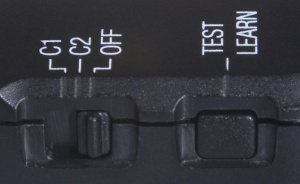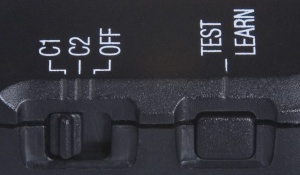Getting Started
1. Download the PocketWizard Utility
Windows
- Download the PocketWizard Utility Version 1.58 Installer for Windows
- Save the installer to the directory of your choice (usually the Downloads folder)
- Run the Installer and follow the installation instructions
- The PocketWizard Utility is now installed in your Start Menu
Mac
- Download the appropriate PocketWizard Utility for your Mac:
- Save the Disk Image file (.dmg) to the directory of your choice (usually the Downloads folder)
- Open the downloaded .dmg file
- Run the PocketWizard installer package within the Disk Image, and follow the installation prompts
- The PocketWizard Utility is now installed in your Applications folder.
2. Check for Updates
MiniTT1, FlexTT5, PowerST4, and PowerMC2
- Launch the PocketWizard Utility
- Connect your radio to your computer via a Mini-B USB cable
- The connected radio will be displayed in the top left of the Utility window.
- Note the current Firmware Version of the connected radio. If the Firmware Version matches the Current Versions listed below, skip steps X to X and proceed to the next radio.
- Under the Update Tab, click Check for Updates, which will download the latest firmware version, and prompt to update the firmware in the connected radio.
- The utility will update the firmware in the connected radio. Do not disconnect the radio while the progress bars are visible.
- After the utility confirms a successful firmware update, disconnect the radio from your computer.
- Perform a Factory Reset of your radio, by holding TEST as you power on the radio for 10 seconds, until you see 4 green blinks in a row. Click here to view a video of this reset process
- Repeat the above steps for all of your radios, making sure all firmware versions match the Current Versions listed below.
Plus III
- Launch the PocketWizard Utility
- Connect your radio to your computer via a Mini-B USB cable
- The connected radio will be displayed in the top left of the Utility window.
- Note the current Firmware Version of the connected radio. If the Firmware Version matches the Current Versions listed below, skip steps X to X and proceed to the next radio.
- Under the Update Tab, click Check for Updates, which will download the latest firmware version, and prompt to update the firmware in the connected radio.
- The utility will update the firmware in the connected radio. Do not disconnect the radio while the progress bars are visible.
- After the utility confirms a successful firmware update, disconnect the radio from your computer, and move the power switch off.
- Perform a Factory Reset of your radio, by holding the TEST button as you power on the radio.
- Repeat the above steps for all of your radios, making sure all firmware versions match the Current Versions listed below.
MultiMAX
- Launch the PocketWizard Utility
- Enable USB Mode on the MultiMAX:
- Turn off the MultiMAX
- Hold the Backlight button (between TEST and MENU), and connect the Mini-B USB cable to your computer
- Continue to hold the Backlight button, and move the power switch to Transmit
- Release the Backlight button
- The connected radio will be displayed in the top left of the Utility window.
- Note the current Firmware Version of the connected radio. If the Firmware Version matches the Current Versions listed below, skip steps X to X and proceed to the next radio.
- Under the Update Tab, click Check for Updates, which will download the latest firmware version, and prompt to update the firmware in the connected radio.
- The utility will update the firmware in the connected radio. Do not disconnect the radio while the progress bars are visible.
- After the utility confirms a successful firmware update, disconnect the radio from your computer, and move the power switch off.
- Perform a Factory Reset of your radio, by holding the C key as you power on the radio.
- Repeat the above steps for all of your radios, making sure all firmware versions match the Current Versions listed below.
Current Firmware Versions
| Radio | Firmware Version | Release Date | Release Notes |
|---|---|---|---|
| MiniTT1 / FlexTT5 Canon | 6.700 | 2014-08-05 | Release Notes |
| MiniTT1 / FlexTT5 Nikon | 3.700 | 2014-08-05 | Release Notes |
| PowerMC2 | 2.400 | 2013-06-11 | Release Notes |
| PowerST4 | 5.400 | 2013-06-11 | Release Notes |
| Plus III | 1.200 | 2013-06-11 | Release Notes |
| MultiMAX | 7.53 | See Manual | |
When available, information about Beta firmware is available here. There are currently no beta firmware releases.
Before You Begin
If this is the first time you are using a remote TTL flash system, we recommend you consult your camera and flash manuals for the basics of positioning your flash units.
Review the owner’s manuals for your camera and flash system. For most basic functions when using Canon or Nikon’s system with PocketWizard's, operation is identical. Important exceptions will be noted in this wiki.
Turn Everything OFF
All equipment should be turned OFF when making connections. If not, unwanted triggering may occur when inserting or removing a flash or connecting a camera cable.
Turn OFF your PocketWizard radios, electronic flash units, cameras, etc., before changing batteries in the flashes, cameras, or radios. See the Batteries section for more information.
ControlTL radios use information presented by the camera and flash when the camera wakes up. If you do not power off your gear when making changes to your equipment, like adding a flash or accessory to the top shoe or changing the camera body in use, then this information is missed and the radios may not perform properly. If you do not power off the equipment, try letting your camera enter a sleep cycle when making equipment changes: wait for the meters to turn off in the viewfinder (entering sleep), then half-press the shutter to exit sleep. This may restore proper operation.
First Shot
The first exposure after making initial connections or powering on may not be properly exposed. The first shot is a camera calibration shot for Canon radios and will not fire your remote flashes. Always test fire at least twice!
Transmitters
You may use a FlexTT5 as a transmitter instead of a MiniTT1 in all scenarios.
Channels
Make sure all PocketWizard radios are set to the same PocketWizard channels. The PocketWizard channel is used instead of Nikon or Canon’s communication channel. See the Channels section for more information.
Don't use REMOTE or SLAVE mode
Always set your remote TTL flashes to standard i-TTL/E-TTL mode. Do not use MASTER, REMOTE, or SLAVE modes on your remote flashes. The ControlTL system talks to your flash via the hot shoe and SLAVE/REMOTE modes do not communicate through the shoe.
Canon flashes set to <SLAVE> and connected to FlexTT5 radios will have slave mode automatically turned off, but will still function as slaves correctly.
Nikon flashes set to REMOTE and connected to FlexTT5 will not function as remotes.
Set the remote/slave group A, B, or C, via the FlexTT5 Zone Switch.
Powering On
- Turn OFF all your PocketWizard radios, electronic flashes, cameras, etc., before making connections.
- When all equipment is connected, turn ON your equipment starting from the top and working your way down.
- Turn on your flash first
- Next, turn on the PocketWizard radio by setting the power switch to C.1 or C.2. Verify Status LED blinks normally (short blink every 2 seconds)
(see the PocketWizard Utility for more information on C.1 and C.2) - Turn on your camera last (if using radio/flash on-camera)
The first exposure after making initial connections and powering on may not be properly exposed. The first shot is a camera calibration shot for Canon and will not fire your remote flashes. Always test at least twice.
NOTE: With Canon radios, a few flash adjustments may not be available when the flash is in the shoe of a powered on MiniTT1 or FlexTT5 and sitting on an active camera. For example, you cannot take a 580EX II out of <MASTER> mode if the flash is in the hot shoe of a powered on remote FlexTT5. Turn the MiniTT1 or FlexTT5 off and wait for the camera to sleep, or remove the flash from the shoe to access these special mode changes.

